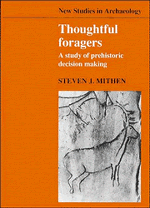Book contents
- Frontmatter
- Contents
- List of figures
- List of tables
- Preface
- 1 Introduction
- PART ONE LEARNING FROM THE PRESENT
- PART TWO MESOLITHIC FORAGING AND SOCIETY
- 4 Broken bones and buried bodies: patterns in the archaeological record
- 5 Gearing up with methodological tools: building a simulation model
- 6 Decision making in the Mesolithic: multiple action replays
- PART THREE UPPER PALAEOLITHIC ART AND ECONOMY
- Bibliography
- Index
4 - Broken bones and buried bodies: patterns in the archaeological record
Published online by Cambridge University Press: 04 August 2010
- Frontmatter
- Contents
- List of figures
- List of tables
- Preface
- 1 Introduction
- PART ONE LEARNING FROM THE PRESENT
- PART TWO MESOLITHIC FORAGING AND SOCIETY
- 4 Broken bones and buried bodies: patterns in the archaeological record
- 5 Gearing up with methodological tools: building a simulation model
- 6 Decision making in the Mesolithic: multiple action replays
- PART THREE UPPER PALAEOLITHIC ART AND ECONOMY
- Bibliography
- Index
Summary
Mathematics, rightly viewed, possesses not only truth, but supreme beauty – a beauty cold and austere, like that of sculpture.
Bertrand Russell, Mysticism and Logic 1918And how will your night dances
Lose themselves. In mathematics?
Sylvia Plath, ‘The Night Dances’At this stage in my study it is time to turn away from some of the terminology I have introduced and follow Ingold back to basics: ‘the hunter and his spear’ (1981, 1986: 1-15). Let us take his advice and consider the simple situation of a lone hunter out in the forest and taking decisions about which game to hunt. It is also time to make life a little more complicated by addressing the archaeological record. Has my polemic as to the need to invoke individual decision making for adequate explanations in archaeology been simply rhetoric and have my lengthy discussions of ecological, psychological and ethnographic data been distractions from my stated aim? Or are we now sufficiently equipped with a qualitative model of decision making to make progress in explaining the variability and patterning in the archaeological record? Now is the time to tell!
It is, of course, the latter. Well, it nearly is. I believe we have an appropriate theoretical framework, but so far lack the methodological tools to operationalise this with the mute stones and bones of the archaeological record. In this case study I am going to use mathematical modelling and computer simulation to play this role. In doing so we must heed Bertrand Russell and view these methods in thier correct guise. I do not pretend that they will provide any magic answers.
- Type
- Chapter
- Information
- Thoughtful ForagersA Study of Prehistoric Decision Making, pp. 91 - 108Publisher: Cambridge University PressPrint publication year: 1990



